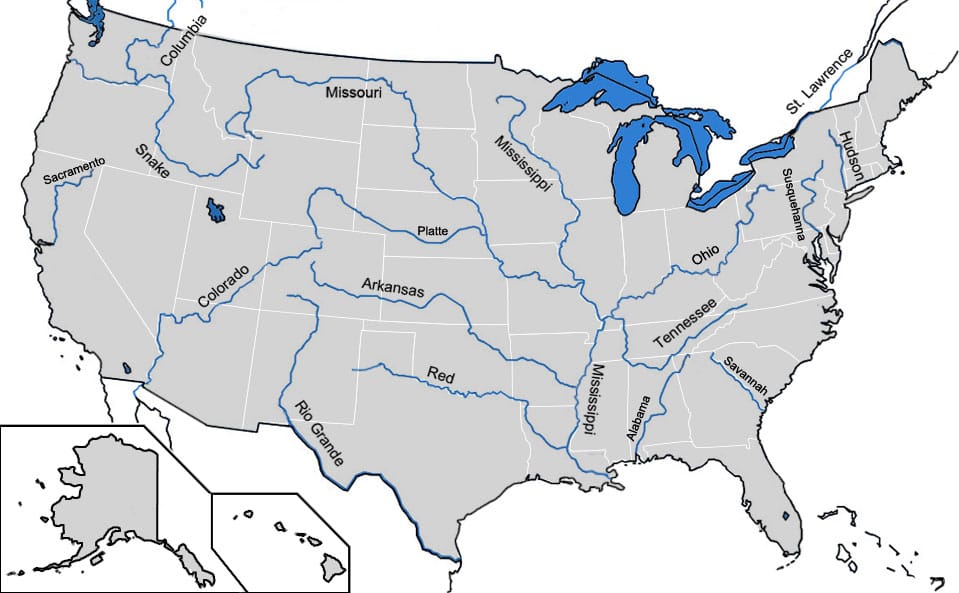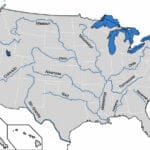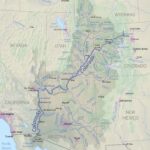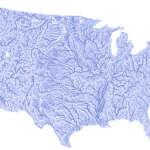Get ready to embark on a riverboat adventure down the most epic waterways in the US! These giants – the Missouri, Mississippi, and Yukon – have sculpted our country’s landscape, woven our history, and nurtured life along their banks. Join us as we dive into their stories, uncovering the marvels that ripple beneath the surface and the secrets hidden in their currents. Prepare yourself for an extraordinary voyage where every twist and turn of the river unveils something new and breathtaking!
Three Longest Rivers in the United States
Let’s take a trip down the three longest rivers in the United States, these amazing waterways that have shaped not just the land, but also the history and culture of our country.
1. The Missouri River: King of the Midwest
First up, we have the undisputed champ, the mighty Missouri River. This giant of a river starts way up in the mountains of Montana and flows all the way down to Missouri, where it finally meets up with the Mississippi River. We’re talking about a whopping 2,540 miles! This river’s nickname is “Big Muddy” – a pretty fitting name when you consider its muddy water flows through a whopping seven states, carving its place right through the heart of America.
2. The Mississippi River: America’s Lifeline
Next, we have the granddaddy of them all, the Mississippi River. Coming in as the second longest river in the US, it winds its way through ten states! That’s a journey of about 2,350 miles, starting in Minnesota and ending all the way down in Louisiana. The Mississippi meanders through the heartland, creating the fertile Mississippi Valley. However, it’s not just about beautiful scenery, this river is a powerhouse! It’s a major route for ships and barges, helps businesses thrive, and provides a home to all sorts of plants and animals. Basically, it’s the lifeblood of the country, impacting both our wallets and our ecosystems.
3. The Yukon River: Alaska’s Wild Heart
Hold onto your hats because our third river takes us on an adventure to Alaska! The Yukon River, a wild and scenic beauty, starts its journey in Canada’s Yukon Territory, flows through Alaska for about 1,980 miles, and finally empties into the Bering Sea. This river is all about pristine beauty and incredible wildlife. It’s like stepping back in time. Plus, it’s still a vital transportation route for the people who live in this rugged and remote part of the world.
The Superteam: The Missouri-Mississippi River System
Here’s a fun fact: the Missouri and Mississippi Rivers don’t just meet, they team up! Along with the Jefferson River, they form the Missouri-Mississippi River System. This interconnected network of waterways is mind-blowing – stretching over 4,000 miles, it’s the longest river system in North America! This super-river is essential to the country, supporting everything from farming and factories to the very towns and cities that line its banks.
Rivers of History and Life
These three rivers are more than just water flowing over land. They represent the incredible variety of landscapes we have in the US, our rich history, and the spirit of the people who live here. They’ve seen it all, from Native American cultures to modern-day life. They’ve shaped communities, supported industries, and provided a home to countless species. These rivers are woven into the very fabric of what it means to be American, a flowing reminder of the power and beauty of the natural world.
What Defines the Three Longest Rivers in the United States?
We already know the U.S. is overflowing with rivers, some stretching farther than others. But how do we decide which ones are the true heavyweights? It all comes down to measuring their “main stems.” Think of it like the trunk of a tree – it’s the primary channel that flows downstream. The longer the main stem, the longer the river is considered to be.
Now, you probably already guessed the king of the hill is the mighty Mississippi River. This behemoth of a waterway dominates the competition, boasting a main stem that stretches a jaw-dropping 2,350 miles. It’s like the Mississippi went on a cross-country road trip, meandering through ten different states! It’s no wonder this river plays such a crucial role in the nation’s commerce and environment.
But hold on, the competition for silver and bronze is fierce! The Missouri River, affectionately known as the “Big Muddy” (and for good reason, given its sediment-rich waters), gives the Mississippi a run for its money. Flowing through seven states, it covers a remarkable 2,540 miles. Yes, you read that right, it actually beats out the Mississippi in pure length! However, when we talk about the “longest river” title, we’re usually referring to the main stem measurement, which explains why the Mississippi still holds the crown.
Last but certainly not least, we have the Yukon River, a breathtaking Alaskan beauty that cuts through the wilderness for 1,980 miles. Picture stunning landscapes and wildlife galore – that’s the Yukon experience.
These three rivers aren’t just impressive for their length; they’re practically the lifeblood of the regions they flow through. They’ve shaped the land, fueled industries, and provided homes for countless creatures. Their waters have witnessed history unfold, making them an integral part of the American story.
Exploring the Mighty Mississippi: A Journey Down the Second Longest River
We’ve already talked about how awesome the Mississippi River is, but let’s dive even deeper!
This river is seriously huge! It stretches for a whopping 2,350 miles, making it the second longest river in all of North America. It starts way up north in Minnesota, in a peaceful lake called Lake Itasca, and then it winds its way south all the way down to the Gulf of Mexico. Think about it: that one river flows through ten different states! It’s no wonder the Mississippi has played such a big role in shaping America’s story.
Imagine all the different types of landscapes the Mississippi passes through on its journey. Up north, it’s all forests and wilderness. Then as it flows south, it encounters farmlands, rolling hills, and eventually, the steamy bayous of the South. This incredible variety of environments means that all sorts of plants and animals call the Mississippi River home. You might spot a majestic bald eagle soaring above the water one minute and then catch a glimpse of a playful otter splashing near the banks the next.
Let’s talk history for a second. Long before European settlers arrived, Native American tribes relied on the Mississippi for food, transportation, and trade. The river was like a lifeline for them, connecting different communities and cultures. Later, when European explorers and settlers arrived, they quickly realized how important the Mississippi was for commerce and travel. Steamboats started chugging up and down the river, carrying goods and people to new settlements and bustling cities. In a way, the Mississippi River helped connect the entire country!
Even today, the Mississippi River is a vital waterway for transporting goods. Farmers use it to ship their crops, factories use it to move raw materials, and businesses use it to transport finished products. It’s like a giant liquid highway!
But it’s not just about practicality. The Mississippi River is also a place of incredible beauty and recreation. Imagine taking a scenic cruise down the river, watching the sun rise over the water, or casting a fishing line in hopes of catching a catfish or a paddlefish. Nature lovers can explore the river’s many tributaries and backwaters, discovering hidden swamps and forests teeming with wildlife. Whether you’re a history buff, a nature enthusiast, or just someone who appreciates a good view, the Mississippi River has something to offer everyone.
Some things to ponder:
- Scientists are still learning about all the different species that live in and around the Mississippi River. Every year, they discover new types of fish, insects, and plants!
- While the Mississippi River is certainly impressive, it experiences its share of challenges. Pollution and habitat loss are ongoing concerns, reminding us of the importance of protecting this vital waterway.
There’s still so much to learn and explore about the Mississippi River. It’s a place that continues to inspire and amaze, and its history is intertwined with the very fabric of America. So, next time you see a map of the United States, take a moment to appreciate the mighty Mississippi and all that it represents.
Unveiling the Missouri: King of the Rivers?
Now, we’ve talked about how impressively long the Missouri River is, but is it really the king of all rivers in the US? Let’s dive into that a bit.
The Missouri River likes to wander. It snakes its way across the country, cutting through mountains and plains for over 2,341 miles. That’s longer than a round trip drive from New York City to Miami! It picks up a lot of dirt and sediment along the way, which is why folks started calling it “Big Muddy.” This nickname is quite fitting, don’t you think?
To put things into perspective, imagine stretching out a ribbon all the way from the Rocky Mountains to where the mighty Mississippi River flows. That’s the kind of distance the Missouri covers! This incredible journey, combined with its sheer size, has led many to crown it the “King of the Rivers.”
But hold on a minute! The Mississippi River isn’t about to be dethroned so easily. Although slightly shorter than the Missouri, it earns its stripes by flowing through a whopping ten states! This grand waterway acts like a major highway, connecting the heartland of America with the bustling Gulf Coast. Think of all the goods and people that have traveled on its currents throughout history. It’s no wonder the Mississippi holds such a special place in our nation’s story.
Then we have the Ohio River, a bit shorter than our top two contenders, but don’t let that fool you! Start your journey down the top 10 states with the most rivers and discover the grandeur of these waterways. And don’t forget to explore the longest river in Oregon, a testament to the state’s natural beauty. It’s like the busy main street running through the heart of America’s industrial centers. The Ohio River has been essential for shipping and trade for a very long time, quietly playing a vital role in the nation’s growth.
And let’s not forget about the other rivers that likely contribute to the top ten longest rivers in the U.S.: the Rio Grande, Snake, Colorado, Arkansas, Red, Columbia, and Brazos. Each one has its own personality, carving its own path, and supporting a rich tapestry of life along its banks. These rivers are more than just lines on a map; they’re the lifeblood of our country.
But here’s the thing: these magnificent waterways face real challenges. Climate change, pollution, and dams all threaten their health and the delicate balance of the ecosystems they support. Scientists suggest that these factors could lead to significant changes in these rivers’ flow and overall health in the future.
Protecting these rivers isn’t just about preserving beautiful scenery; it’s about safeguarding our future. We need to think carefully about how we use water, manage pollution, and protect the natural habitats along these vital waterways. It’s a big job, but by working together, we can help ensure that these majestic rivers continue to flow for generations to come.
So, is the Missouri River truly the king? It depends on how you define “king.” By length, it certainly takes the crown. But each of these rivers plays a crucial role in the grand tapestry of our nation. Perhaps they are all royalty in their own right.
- Crypto Quotes’ Red Flags: Avoid Costly Mistakes - June 30, 2025
- Unlock Inspirational Crypto Quotes: Future Predictions - June 30, 2025
- Famous Bitcoin Quotes: A Deep Dive into Crypto’s History - June 30, 2025
















